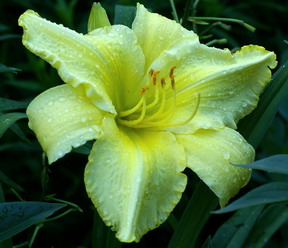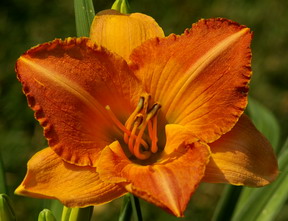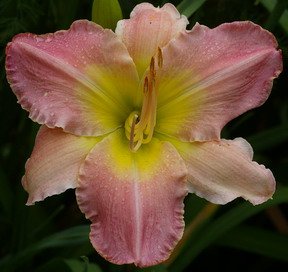|
Daylilies Of Many Colours
|

Why Would I Plant Them?
Unless you have a large wild space to fill, you would never plant these old species. However; the new modern Daylilies are another story altogether. They have the strength, ease of cultivation and month long blooming period of the original species but they have lost their invasive tendencies. They form nice discrete clumps and behave themselves in a perennial garden.
Is It Just Orange and Yellow?
Absolutely not. The modern daylily breeders have significantly increased the colour palette. They now range from the deepest purple through many variations of red and pink and on to gold, orange and a wide spectrum of yellows. No blue or no true white but many of them now have several colours in the same blossom. In Daylily terms there is the main colour and then the ‘water mark’ as you move into the blossom and in the centre the ‘throat’. There are also ruffles and frills around the edge of the petals and some of them are even in different colours to the main colour.
 When Do They Bloom?
When Do They Bloom?
July is the big month for Daylilies but some of mine start in mid June and the later varieties are still providing colour well into mid August. This is the true joy and one of the great reasons to have a selection of these in your garden. They bloom when there are few other things providing colour in the perennial border. They are called Daylilies for a reason. Each flower only opens for one day. Each plant however will produce several scapes, (fancy term for flowering stalks,) and each of them will carry up to a dozen blooms. The plants and blooms also come in a range of sizes from delicate miniatures about 25 - 30 cm high with 4 - 8 cm blooms, to the giants whose scapes will reach 100 - 125 cm tall and produce a succession 15 cm blooms.

Problems?
Daylilies have very few problems. There are no significant insect problems and no regularly appearing diseases that do any significant damage. A clump of Daylilies will continue to grow and produce flowers for 7 - 10 years. Some of the old ‘ditch lilies’ have been in the same place for decades. The newer varieties will eventually reduce the size and number of bloom stalks or the clump may just get to big for its garden space. They are very agreeable movers. They can be dug, divided and replanted at almost any time. Late fall is the poorest time as the have the least time to get reestablished before winter. They can even be moved when they are in flower and that lets us all go to the Daylily nursery in mid July and choose the exact colour and style that we need to add to our collection.
Trouble free; free flowering; bright colours; midsummer blooms; what more could we want from a good perennial.
Get answers to your gardening questions by subscribing to
Ken’s free newsletter, Dallying In The Dirt
return from Daylilies to Perennials main page
